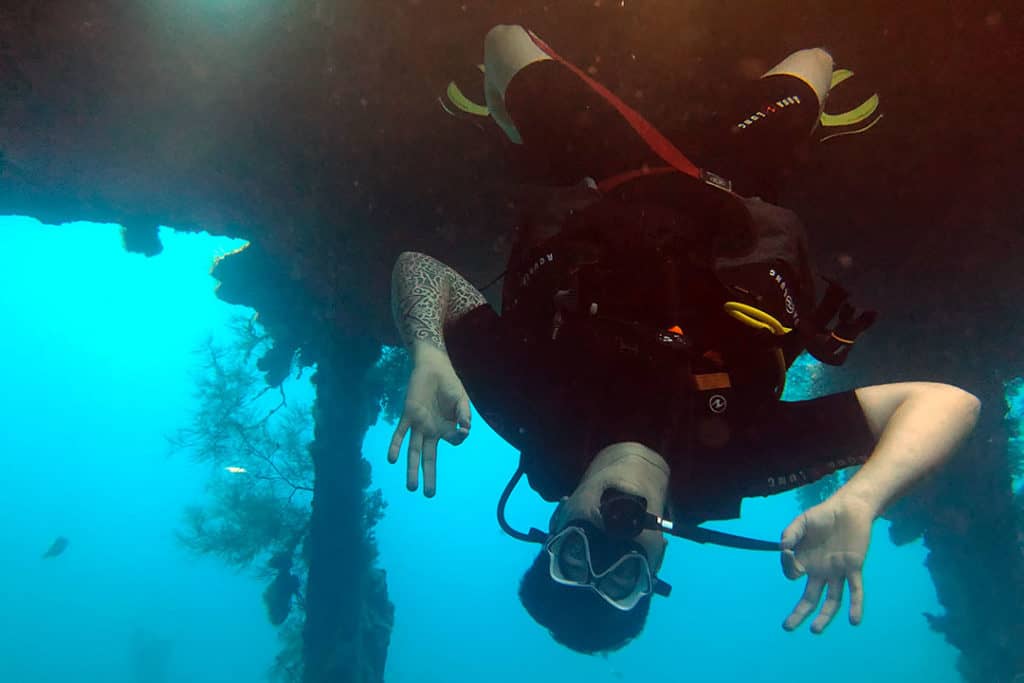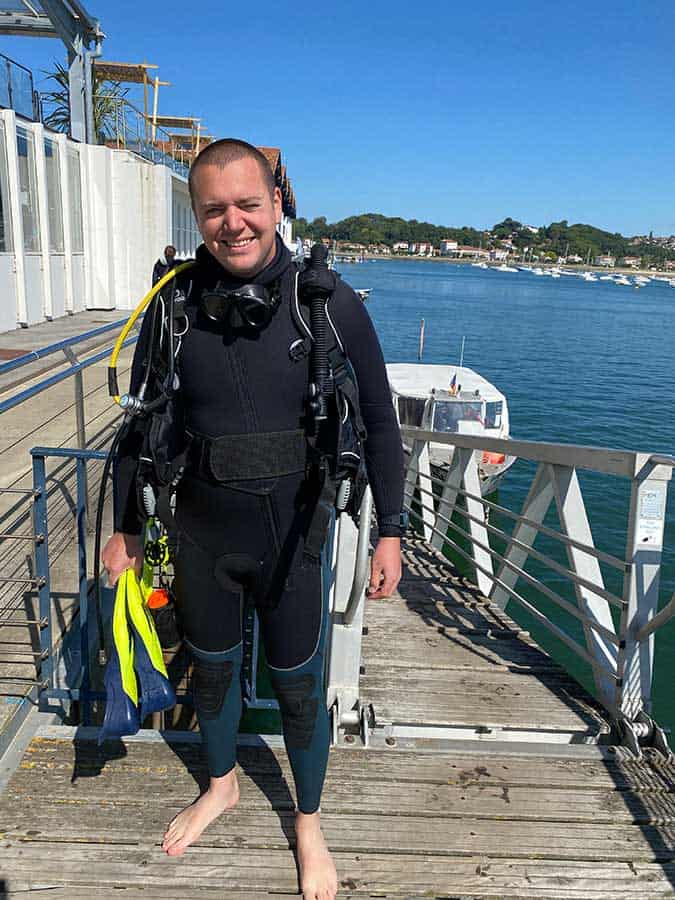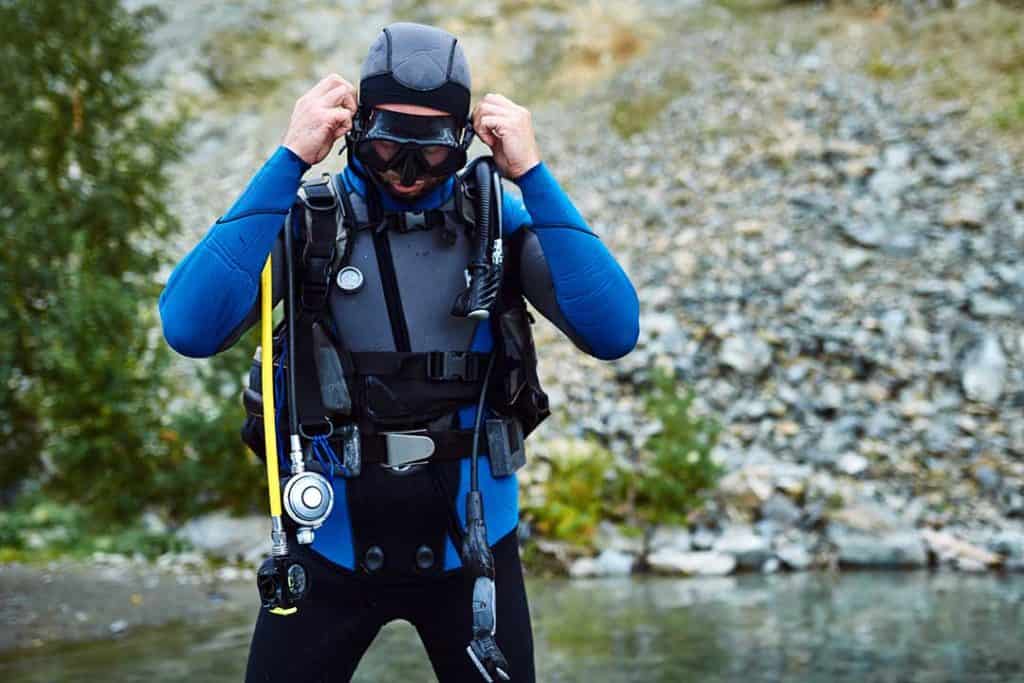Many of us learned to dive in warm tropical waters. If we wore a wetsuit at all, it was likely just 3 mm thick.
Over time, we might start looking at diving in colder waters. It might be because our local diving has colder waters or a special destination has got our attention.
A quick look at dry suit prices and the training required might turn us off from that option. The logical question becomes:
How cold can you dive in a wetsuit?
As a general rule, you can scuba dive in a wetsuit in water as cold as 35 degrees Fahrenheit (2 degrees Celsius). The thickness of the wetsuit, individual differences and activity levels are determining factors
Individual Differences and Activities
We all know someone, or maybe it is us, that has a sweatshirt on and is shivering when everyone else is out wearing shorts.
People react differently to temperatures both on land and in the water. If you get cold easy, then add more protection. Just make sure you do not over do it and overheat.
The activity you are doing and your exertion are also factors. If you are being very active in your dive, your body will generate more heat and you need less thermal protection.
On the other hand, if you are doing a drift dive, your activity level will be low.
The information here is for wetsuits needed for scuba diving in cold water. A surfer or other surface water sport enthusiast would not need as much protection.
How deep you will be diving is also a factor to consider.
Water may be colder at depths, however, more importantly the deeper you go the more compressed your wetsuit will become resulting in less thermal protection.
Wetsuit Thickness For Cold Water Diving.
Wetsuits are not meant to keep you dry.
They are meant to slow the lost of body heat, and are made from neoprene.
Neoprene is a foam like synthetic rubber that is water resistant, not waterproof.
When you enter the water, the suit absorbs water and traps it near your skin. The water is warmed by your body, creating a layer of insulation.
This slows the heat lost. The thicker the insulation, the slower the water will give up the heat.
The core of your body is the most critical to keep warm. If your core temperature drops too low, you will enter hyperthermia, which can be life threatening.
When you dive in cold water, you may want to add a hood, gloves and boots. The head, feet and hands are the parts of the body that lose heat the fastest.
Wetsuit thickness are measured in millimeters (mm).
We will see measurement such as 3 mm or 5 mm as an example. We may also see two numbers separated by a slash, such as 7/5 mm.
This tells us that the core or torso portion of the wetsuit is 7 mm thick and the arms and legs are 5 mm thick.
The thicker core helps keep you warmer, while the slightly thinner arms and legs give your more range of movement.
| Water Temperature | Recommended Wetsuit Thickness |
|---|---|
| Above 80 Degrees F (26°C) | 2mm or rash guard |
| 73 to 79 Degrees F (22-25°C) | 3mm full wetsuit or shorty |
| 66 to 72 Degrees F (18-21°C) | Full 5mm wetsuit + Hood, Booties & Gloves |
| 50 to 65 Degrees F (10-17°C) | Full 7mm wetsuit. + Hood, Booties & Gloves |
| 35-50 Degrees F (2-10°C) | 8 or 9mm Full Set. (Or Dry Suit) |
Here are some suggested thickness for wetsuits at different water temperatures.
Remember, everyone has different tolerances and your level of activity will influence your needs.
- Water above 80 Degrees F (26 C). Most divers will not need a wetsuit in water this warm, however, a rash guard or 2 mm wetsuit may be a good choice for protection from the sun and scrapes.
- Water from 73 to 79 Degrees F (22-25 C). In the air, this is the temperature range that most people find the most comfortable. However, in the water it can reduce your body core temperature to a dangerous level. A 3 mm wetsuit, either full or a shortie, will keep most divers comfortable and let them maintain the proper body temperatures.
- Water from 66 to 72 Degrees F (18-21 C). You will find that most divers diving in these water temperatures will be wearing a full 5 mm wetsuit. Many will also be wearing gloves, thicker booties and a hood.
- Water from 50 to 65 Degrees F (10-17 C). This is where most divers consider the start of cold water diving. The wetsuit you will want here will likely be a 7 mm or a 7/5 mm complete with hood, booties and gloves. Now that you are entering the range of cold water diving, your regulators should be rated for cold water. Standard regulators may freeze at these temperatures.
- Water from 35-50 Degrees F (2-10 C). While many divers diving in waters this cold will switch to a dry suit, others will use an 8 or 9 mm suit or an 8/7 mm suit.
As you can see, the answer to “How cold can you dive in a wetsuit”, is just above the water freezing.
Types of Wetsuits
How cold can you dive in a wetsuit is mostly about the thickness of the suit. However, the style can also come in to play.
Here are the most common styles of wetsuits for cold water diving.
Shorties

This is a warm water wetsuit no thicker than 3 mm. It has sleeves that stop above the elbows and legs that stop above the knees.
While not very useful by itself for cold water diving, it can be worn over a 5 mm full suit to provide a close equivalent to an 8/5 mm suit.
Full Suits

These are the most common wetsuits for scuba diving, and are often found in thicknesses from 3 to 9 mm.
They generally have a zipper in the back, with long sleeves and legs. The legs and arms will have a seal or a cuff.
Two Piece

A two-piece suit is a pair of pants and a jacket. The jacket and pants generally are snapped together after you put them on, with the jacket extending below the top of the pants.
Also, it is common for the jacket to have an extension that comes from the back between the legs and snaps to the front.
Farmer John/Jane
This style is similar to the two-piece except the pants resembles a pair of farmer’s bib overalls. The bib portion provides additional coverage of the torso.
Seams and Seals for Cold Water Wetsuits
As you will recall as we talked about how a wetsuit works, water is trapped next to your body and heated.
This works great for whole pieces of neoprene. However, the neoprene has to be cut and stitched together to create a wetsuit that will fit you.
The seams where the suit is stitch together can allow water in that flushes the warmed water out. Here are the common type of stitching for seams.
- An overlock stitch is the simplest and cheapest type of stitching and is found on most inexpensive and surface use wetsuits. It does little to keep water out and is not suitable for cold water diving.
- A flatlock stitch is a bit better and found in some diving wetsuits. However, they also allow some water seepage.
- A blind stitched has the two parts of neoprene glued together and then stitched together without the stitching going all the way through. This is the most effective stitch to keep water out.
The seams are also sealed to help keep the water out.
- Glue seams are made when the pieces of neoprene are glued together before the stitching. This will reduce the amount of water to seep into the seam.
- Taped seams have neoprene tape glued to the outside of the seams, this reduces the seepage and improves the flexibility.
- Liquid tape is a special liquid rubber applied to the seam and makes it 100 percent waterproof.
As you can see, your best choice is a blind stitched with a taped or liquid tape seal.
Get A Cold Water Wetsuit and Keep Diving!
How cold can you dive in a wetsuit, is mostly a matter of the proper wetsuit and your personal comfort level with cold.
While thicker wetsuits reduce your mobility, then do allow you to extend your diving season greatly. The NOAA website and the National Weather Service website can give you information about water temperatures where you are planning on diving.
How cold will you dive in a wetsuit?
If you have any questions or comments you wish to add, please leave them in the comments section below.